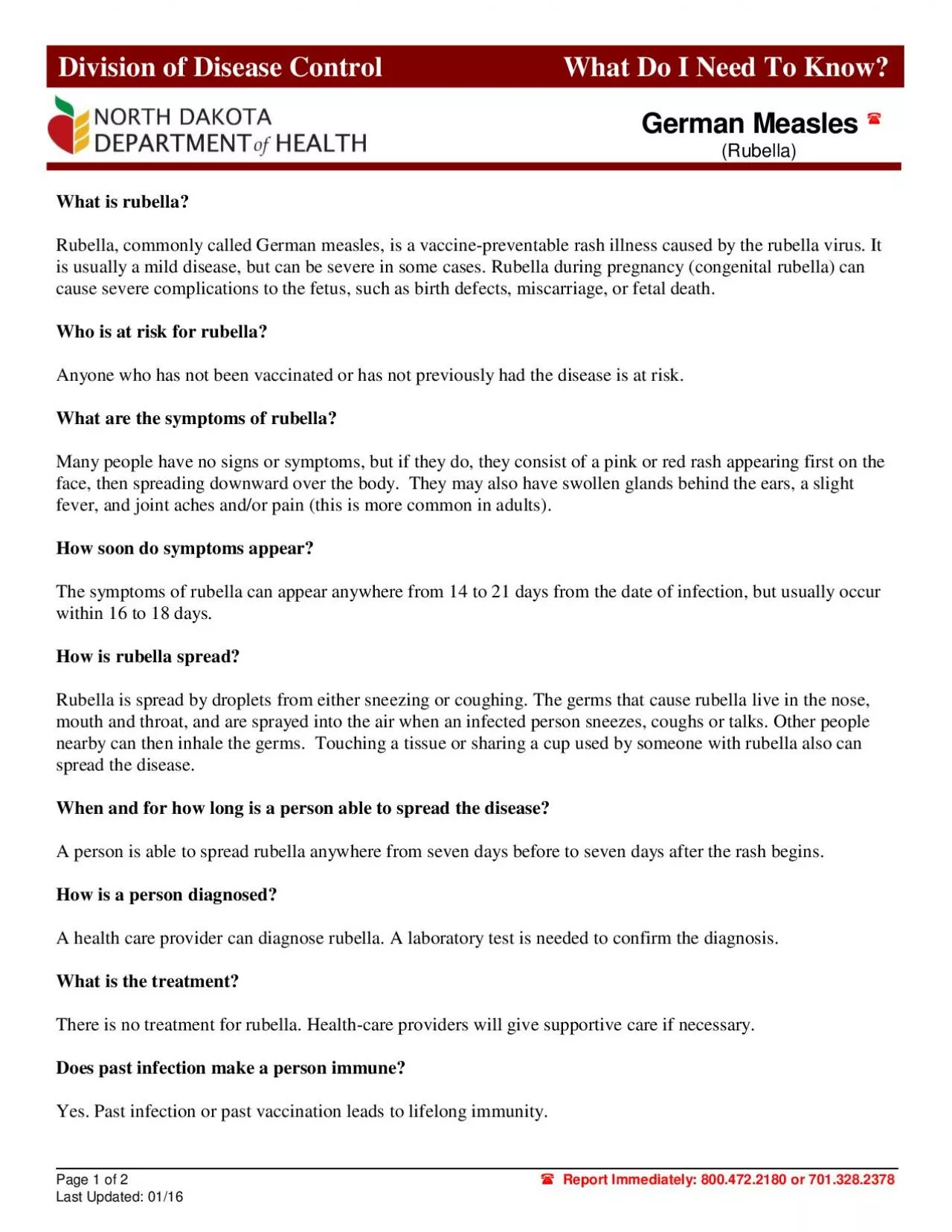

P age 1 of 2 8004722180 or 7013282378 Last Updated 0 116 German Measles Rubella What is r ubella Rubella commonly called German measles is a va ccine preventable rash ID: 958629
Download Pdf The PPT/PDF document "Report Immediately" is the property of its rightful owner. Permission is granted to download and print the materials on this web site for personal, non-commercial use only, and to display it on your personal computer provided you do not modify the materials and that you retain all copyright notices contained in the materials. By downloading content from our website, you accept the terms of this agreement.
P age 1 of 2 Report Immediately: 800.472.2180 or 701.328.2378 Last Updated: 0 1/16 German Measles ( Rubella ) What is r ubella ? Rubella , commonly called German measles, is a va ccine - preventable rash illness caused by the rubella virus. It is usually a mild disease, but can be severe in some cases. Rubella during pregnancy (congenital rubella) can cause severe complications to the fetus , such as birth defects, miscarriage, or fet al death . Who is at risk for r ubella ? Anyone who has not been vaccinated or has not previously had the disease is at risk. What are the symptoms of r ubella ? Many people have no signs or symptoms, but if they do, they consist of a pink or red rash appearing first on the face, then spreading downward over the body. They may also have swollen glands behind the ears, a slight fever, and joint aches and/or pain (this is more common in adults). How soon do symptoms appear? The symptoms of r ubella c an appear anywhere from 1 4 to 2 1 days from the date of infection, but usually occur within 16 to 18 days. How is r ubella spread? Rubella is spread by droplets from either sneezing or coughing. The germs that cause rubella live in the nose, mouth and throat , and are sprayed into the air when an infected person sneezes, coughs or talks. Other people nearby can then inhale the germs. Touching a tissue or sharing a cup used by someone with rubella also can spread the disease. When and for how long is a person able to spread the disease? A person is able to spread r ubella anywhere from seven days before to seven days after the rash begins . How is a person diagno sed? A health care provider can diagnose rubella. A laboratory test is needed to confirm the diagnosis. What is the treatment? There is no treatment for rubella. Health - care providers will give supportive care if necessary. Does past infection make a person immune? Yes. P
ast infection or past vaccination leads to lifelong immunity. Division of Disease Control What D o I Need T o Know? P age 2 of 2 Report Immediately: 800.472.2180 or 701.328.2378 Last Updated: 0 1/16 Should children or others be excluded from child care, school, work or other activities if they have r ubella ? Yes . R ubella is a highly contagious disease. In outbreak situations , exposed children who have not been immunized should be excluded . Also, if the children have exemption s for not being immunized, they should be excluded until the North Dakota Department of Health determines it is safe for them to return. What can be done to prevent the spread of r ubella disease? 1. All c hildren between 12 and 15 months of age should be vaccinated with the first dose of MMR (measles, mumps and rubella vaccine) . A booster dose of MMR is recommended at 4 to 6 years of age. A combi nation vaccine is also available (MMRV) , which protects against measles, mumps, rubella and chickenpox . Children are required to be age - appropriately immunized against rubella in order to attend early childhood facilities , schools, and colleges in North Da kota. 2. The immunization status of all children and staff at the school or early childhood facility should be reviewed. 3. During rubella outbreaks, exposed children and staff who have not been immunized should be excluded until they are vaccinated, or if they refuse , they should continue to be excluded until the North Dakota Department of Health determines it is safe for them to return. The vaccine may provide some protection if given after exposure. 4. Routine hand washing also helps prevent the spread of rubella . Additional I nformation : Additional information i s available at www.ndhealth.gov/disease or by calling the North Dakota Department of Health at 800.472.2180. This disease is a reportable condition. As mand ated by North Dakota law, any incidence of this disease shall be reported to the North Dakota Department of Healt h. Resource: American Academy of Pediatrics. [Rubella ] . In: Kimberlin DW, Brady MT, Jackson MA, Long SS, eds. Red Book: 2015 Report of the C ommittee on Infectious Diseases. 30 th ed. Elk Grove Village, IL: American Academy of Pediatrics; 2015: 688 - 695 .